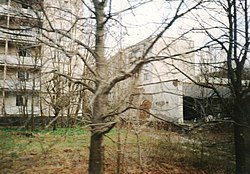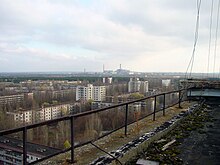| Revision as of 11:58, 12 December 2006 edit84.24.72.223 (talk)No edit summary← Previous edit | Revision as of 20:32, 19 December 2006 edit undoCiri5678 (talk | contribs)1,187 editsNo edit summaryNext edit → | ||
| Line 10: | Line 10: | ||
| Contrary to ], access to Prypiat was not restricted prior to the disaster. Before the Chernobyl accident, ]s were seen by the ] as safe as any other type of power plant. Nuclear power stations were presented as being an achievement of Soviet engineering, where nuclear power was harnessed for peaceful projects. The slogan "peaceful atom" (]: мирный атом) was popular during those times. Initially the plant was intended to be built only 25 km from ], but the ], among other bodies, expressed concern about the station being too close to the city, and so the station, together with Prypiat, were built in their current location - about 100 km from Kiev. | Contrary to ], access to Prypiat was not restricted prior to the disaster. Before the Chernobyl accident, ]s were seen by the ] as safe as any other type of power plant. Nuclear power stations were presented as being an achievement of Soviet engineering, where nuclear power was harnessed for peaceful projects. The slogan "peaceful atom" (]: мирный атом) was popular during those times. Initially the plant was intended to be built only 25 km from ], but the ], among other bodies, expressed concern about the station being too close to the city, and so the station, together with Prypiat, were built in their current location - about 100 km from Kiev. | ||
| Until recently, the site was practically a museum, documenting the late Soviet era. ]s (four of which were recent constructions not yet occupied), ]s, hospitals and other buildings were all abandoned, and everything inside the buildings |
Until recently, the site was practically a museum, documenting the late Soviet era. ]s (four of which were recent constructions not yet occupied), ]s, hospitals and other buildings were all abandoned, and everything inside the buildings were left behind, including records, papers, TV's, children's toys, and clothing. Residents were only allowed to take away a suitcase full of documents, books and clothes that were not contaminated. | ||
| However, the apartment buildings were completely looted some time around the beginning of the 21st century. Nothing of value was left behind; even ]s were taken away. Because the buildings are not maintained, the roofs leak, and in spring the rooms are swamped with water. It is not unusual to find trees growing on roofs and even inside buildings. This hastens deterioration, and in a few decades the city will most probably lie in ruins. | However, the apartment buildings were almost completely looted some time around the beginning of the 21st century. Nothing of value was left behind; even ]s were taken away. But some buildings have been untouched. A lot of the interiors of buildings have been vandalized and ransacked over the years. Because the buildings are not maintained, the roofs leak, and in spring the rooms are swamped with water. It is not unusual to find trees growing on roofs and even inside buildings. This hastens deterioration, and in a few decades the city will most probably lie in ruins. | ||
| Prypiat and the surrounding area will not be safe for human habitation for several centuries to come. The most troublesome ] ] (]) released by the accident (external ] exposure short biological halflife in humans) will take 300 years to decay to one thousandth of its present level. The ]-90 will decay to a similar time scale. Strontium is a ] emitter with a long ] in humans, which can cause disease through internal exposure. After the caesium activity has decayed to this level, the area may be used for most human activities again. The graph below shows that caesium is responsible for almost the entire gamma dose rate due to the accident experienced in Prypiat. This has not prevented ] from entering the area; wild animal populations are actually quite large in the exclusion zone, capitalizing on the lack of human occupation. Statistics are not yet widely available to indicate changes in animal reproductive cycles nor mortality rates. | Prypiat and the surrounding area will not be safe for human habitation for several centuries to come. The most troublesome ] ] (]) released by the accident (external ] exposure short biological halflife in humans) will take 300 years to decay to one thousandth of its present level. The ]-90 will decay to a similar time scale. Strontium is a ] emitter with a long ] in humans, which can cause disease through internal exposure. After the caesium activity has decayed to this level, the area may be used for most human activities again. The graph below shows that caesium is responsible for almost the entire gamma dose rate due to the accident experienced in Prypiat. This has not prevented ] from entering the area; wild animal populations are actually quite large in the exclusion zone, capitalizing on the lack of human occupation. Statistics are not yet widely available to indicate changes in animal reproductive cycles nor mortality rates. | ||
| Line 18: | Line 18: | ||
| and the second edition of 'The radiochemical manual'.]] | and the second edition of 'The radiochemical manual'.]] | ||
| The city |
The city and the Exclusion Zone are now bordered with guards and police, but with easily achieved documentation, entering the zone is easy. A guide will accompany you to make sure that you do not vandalize anything or take anything from the zone. The city of Chernobyl, which is located a few miles from Prypiat is fully accompanied, with a hotel, many apartment buildings, and a local lodge. Entering into the zone, zone officials will provide you with a ] and a ] for the least protection from the radiation. The doors of most of the buildings are open to reduce the risk to visitors, and almost all of them you can visit accompanied by your guide. | ||
| Beginning in ], shortly after the disaster, the city of ] was constructed to replace Prypiat. | Beginning in ], shortly after the disaster, the city of ] was constructed to replace Prypiat, in which where plant workers and scientists live there, 2nd to the city of Chernobyl. | ||
| == See also == | == See also == | ||
Revision as of 20:32, 19 December 2006
51°24′20″N 30°03′25″E / 51.40556°N 30.05694°E / 51.40556; 30.05694



Prypiat (Template:Lang-uk; Template:Lang-ru; 51°24′20″N 30°03′25″E / 51.40556°N 30.05694°E / 51.40556; 30.05694) is an abandoned city in the zone of alienation in northern Ukraine, Kiev Oblast, near the border with Belarus. It was home to the Chernobyl Nuclear Power Plant workers. The city was abandoned in 1986 following the Chernobyl disaster. Its population had been around 55,000.
Contrary to cities of military importance, access to Prypiat was not restricted prior to the disaster. Before the Chernobyl accident, nuclear power stations were seen by the Soviets as safe as any other type of power plant. Nuclear power stations were presented as being an achievement of Soviet engineering, where nuclear power was harnessed for peaceful projects. The slogan "peaceful atom" (Russian: мирный атом) was popular during those times. Initially the plant was intended to be built only 25 km from Kiev, but the Ukrainian Academy of Sciences, among other bodies, expressed concern about the station being too close to the city, and so the station, together with Prypiat, were built in their current location - about 100 km from Kiev.
Until recently, the site was practically a museum, documenting the late Soviet era. Apartment buildings (four of which were recent constructions not yet occupied), swimming pools, hospitals and other buildings were all abandoned, and everything inside the buildings were left behind, including records, papers, TV's, children's toys, and clothing. Residents were only allowed to take away a suitcase full of documents, books and clothes that were not contaminated.
However, the apartment buildings were almost completely looted some time around the beginning of the 21st century. Nothing of value was left behind; even toilet seats were taken away. But some buildings have been untouched. A lot of the interiors of buildings have been vandalized and ransacked over the years. Because the buildings are not maintained, the roofs leak, and in spring the rooms are swamped with water. It is not unusual to find trees growing on roofs and even inside buildings. This hastens deterioration, and in a few decades the city will most probably lie in ruins.
Prypiat and the surrounding area will not be safe for human habitation for several centuries to come. The most troublesome radioactive isotope (caesium-137) released by the accident (external gamma exposure short biological halflife in humans) will take 300 years to decay to one thousandth of its present level. The strontium-90 will decay to a similar time scale. Strontium is a beta emitter with a long biological halflife in humans, which can cause disease through internal exposure. After the caesium activity has decayed to this level, the area may be used for most human activities again. The graph below shows that caesium is responsible for almost the entire gamma dose rate due to the accident experienced in Prypiat. This has not prevented wildlife from entering the area; wild animal populations are actually quite large in the exclusion zone, capitalizing on the lack of human occupation. Statistics are not yet widely available to indicate changes in animal reproductive cycles nor mortality rates.

The city and the Exclusion Zone are now bordered with guards and police, but with easily achieved documentation, entering the zone is easy. A guide will accompany you to make sure that you do not vandalize anything or take anything from the zone. The city of Chernobyl, which is located a few miles from Prypiat is fully accompanied, with a hotel, many apartment buildings, and a local lodge. Entering into the zone, zone officials will provide you with a Geiger counter and a gas mask for the least protection from the radiation. The doors of most of the buildings are open to reduce the risk to visitors, and almost all of them you can visit accompanied by your guide.
Beginning in 1986, shortly after the disaster, the city of Slavutych was constructed to replace Prypiat, in which where plant workers and scientists live there, 2nd to the city of Chernobyl.
See also
External links
- Site about Pripyat created by its former residents. Contains photos from the deserted town of Pripyat and much other useful information
- Pripyat Ghost Town (1970-1986): a tale by Elena Filatova with photos
- Greenpeace pictures with no text
- town Pripyat forum - in Russian -
- Pripyat message board (requires registration and approval)
- Gallery from Prypiat City (www.opuszczone.com)
- Pripyat - Ghost Town II (www.opuszczone.com)
- The Chernobyl Poems of Lyubov Sirota
- Prypyat on Soviet map (1986)
- Prypiat in modern and old photos
- WikiSattelite view of Pripyat and Nuclear station at WikiMapia